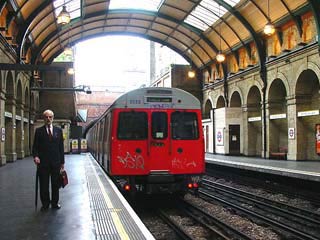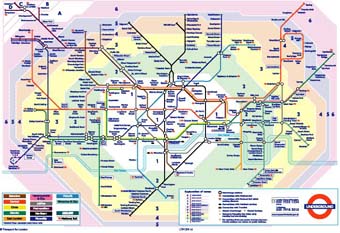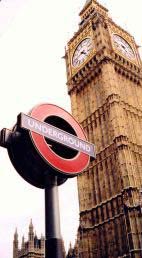Introduction
Mind the gap! Mind the gap!
| |
 |
| |
Photo by Amy,
http://amyrtw.com |
| |
London's "Tube" is the heart of its public transportation
system. Boston has the T, Montreal and Paris share the moniker
"Metro," Chicago has the El, and so on.
History
The London Underground, or Tube, is an electric railway public
transport network (a metro or subway system) that runs both above
and below ground throughout the Greater London area. It is the
oldest such transit system in the world. Operations began on 10
January 1863 on the Metropolitan Railway — most of the initial
route is now part of the Hammersmith & City Line.
The London Underground is usually referred to as either simply
"the Underground" by Londoners, or (more familiarly) as "the Tube",
due to the shape of its deep-bore tunnels.
The Underground currently serves 274 stations and runs over 253
miles (408 km) of lines. There are also a number of stations and
tunnels which are now closed. In 2004-05 total passenger journeys
reached a record level of 976 million, or an average of 2.67
million per day. The first section of the London Underground (the
"Metropolitan Railway", running between Paddington and Farringdon)
opened to public traffic on 10 January 1863. 40,000 passengers were
carried over the line that day, with trains running every 10
minutes; by 1880 the expanded 'Met' was carrying 40 million
passengers a year.
Other lines swiftly followed, and by 1884 the Circle Line
("Inner Circle") was completed. All these early lines used
steam-hauled trains, which required effective ventilation to the
surface. Advances in electric traction later
 |
|
Photo by Tim Griffiths,
http://www.antipodean.org/ |
|
| |
allowed tunnels to be placed deeper underground than the original
cut-and-cover method, especially as deep-level tunnel design
(including the use of tunnelling shields) improved. The first
"deep-level" line, the City & South London Railway, now part of
the Northern Line, opened in 1890.
In the early 20th century the presence of six independent
operators running different Tube lines caused passengers
substantial inconvenience; in many places passengers had to walk
some distance above ground to change between lines. This eventually
changed.
Fares
London Underground uses Transport for London's Travelcard zones
for all fares, including Underground-only fares. Travelcard Zone 1
is the most central, with a boundary just outside the Circle Line.
Most of inner London is within Travelcard Zone 3. Zones 1 to 6
cover all of Greater London and a few extra stations; the remaining
zones are named A, B, C and D, of which zone D is the most remote
and consists of Amersham and Chesham out in the Chiltern Hills on
the Metropolitan Line. These lettered zones cater for the rural
extremities of the tube and do not encircle the capital.
| |
 |
| |
Tube Map |
| |
Graphics
London Transport's tube map and roundel logo are instantly
recognisable by any Londoner, almost any Briton, and many people
around the world. The stylised Tube map as we now know it (original
maps were often street-maps with the location of the lines
superimposed) evolved from an original design by electrical
engineer Harry Beck in 1931.
The origins of the "roundel" logo, which in earlier years was
known as the 'bulls-eye' or 'target', stems from the decision in
1908 to find a more obvious way of highlighting station names on
the systems platforms. The red disc, with blue name bar, was
quickly adapted, with the use of the word "UNDERGROUND" across the
bar, as an early corporate identity. The logo was modified by
Edward Johnston in 1919.
Trivia
An estimated half a million mice live on the Underground system,
and can often be seen running around the tracks. TV personality
Anthea Turner has written a series of children's books about these
London Underground mice.
Only two people have had their coffins transported on the
Underground: William Gladstone and Dr Barnardo.
Regent's Park, Piccadilly Circus, Hyde Park Corner, Westminster,
and Bank stations have no associated buildings at or above ground
level, the stations, except for access stairs, being entirely
underground.
On 13 May 1924, a woman named Daisy Hammond gave birth on a
Bakerloo Line train at Elephant and Castle. Press reports that the
baby had been named Thelma Ursula Beatrice Eleanor were widely
reprinted, and not debunked until 2000 when she was traced for a TV
interview. In fact she was named Mary Ashfield Eleanor; the
chairman of the Underground Group, Lord Ashfield, was her
godfather.
 |
|
| Look kids, Big Ben. |
|
| |
The record for visiting all 275 stations in the shortest
possible time currently stands at 18 hours, 35 minutes and 43
seconds. It is held by Geoff Marshall and Neil Blake.
St John's Wood is the only station which contains none of the
letters of the word 'mackerel'.
In January 2005 London Underground announced that it would play
classical music at stations prone to loitering by youths. A trial
had shown a 33% drop in abuse against staff. This had been first
tried, with success, on the Tyne and Wear Metro.
There are only two tube stations that have all five vowels in
them — South Ealing and Mansion House. Heathrow Terminal 4 also
contains all five vowels, if 4 is spelled out as four.
A fragrance called "Madeleine" was introduced at St James's
Park, Euston and Piccadilly Circus stations on 23 March 2001, in an
effort to make the tube smell better. It was taken out of action on
24 March 2001, as it was making people feel sick.
The Jubilee Line is the only line which intersects all others.
The District Line meets all other lines except the Metropolitan
Line — which it misses by approximately 20 m at Aldgate.
Arsenal is the only tube station named after a London football
club (it was previously known as Gillespie Road). West Ham comes
close, but the full name of the football club is West Ham
United.
Okay, enough already, let's get started.
Manchester doesn't have a subway but we have our very own
highways. Manchester was built on water power. Our mill buildings
are proof of that. But now we are at a confluence of roads. 93,
293, 101 all come together and envelope Manchester. This cache is
about highways, but also about what highways replaced.
The cache is a micro cache, there is no room for any trinkets of
any kind. The logbook may be wet but it is made of waterproof
paper. Please bring a pencil or ballpoint pen to sign the log.
Do NOT stop on the highway to solve this cache. It is
certainly dangerous and also unnesscessary.
You do not need to go poking about in the brush to find the
physical cache. You should be able to see it quite easily, but of
course (heh heh heh) you need to be looking in the exact right
place! Snow should not stop you from finding the cache and let me
know if the logbook is filling up. Because of cover, I had a
great deal of trouble getting signal so the coordinates may be a
bit off. Sorry about that.
Please don't upload any photos showing the cache location. Let
others enjoy the surprise. Thanks.
Hints
The cache is not in a fake bolt or fastener or any object
hanging off of Frankenstein's neck. Also, the cache is more than 1
foot off the ground so there is no need to play around in the
broken glass.
While you are on campus, perhaps you might like my other
Manchester cache, the virtual
Lest We Forget. Thanks to Wikipedia for the London Tube history
lesson.